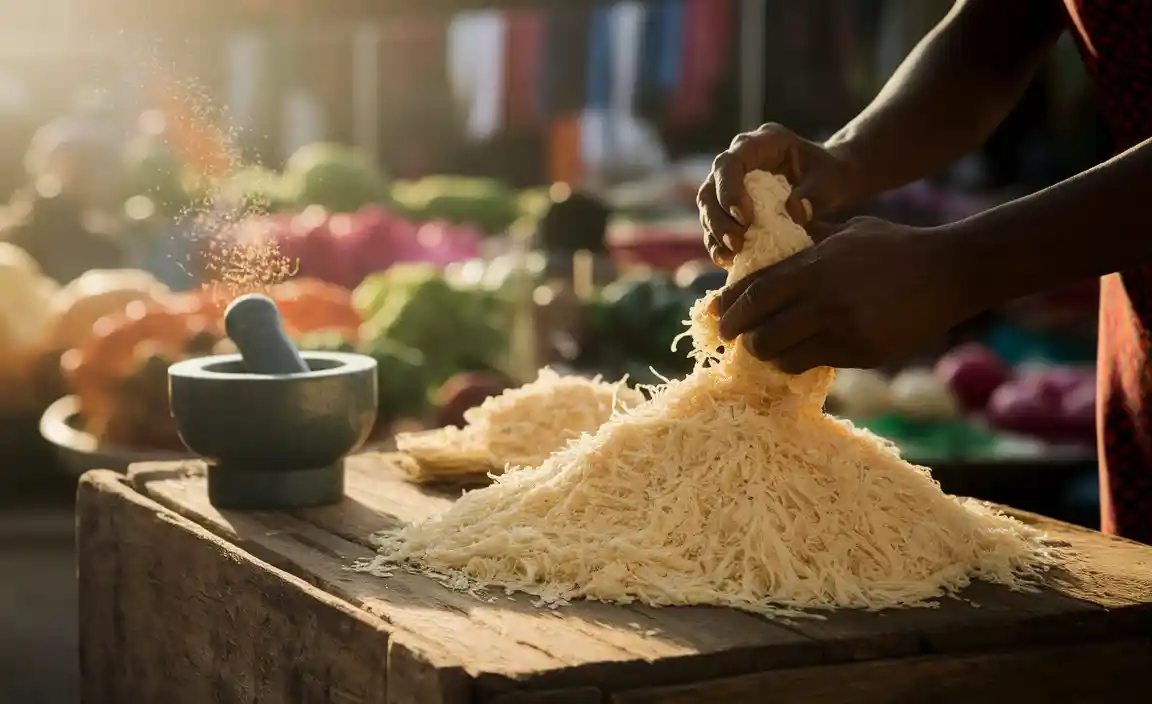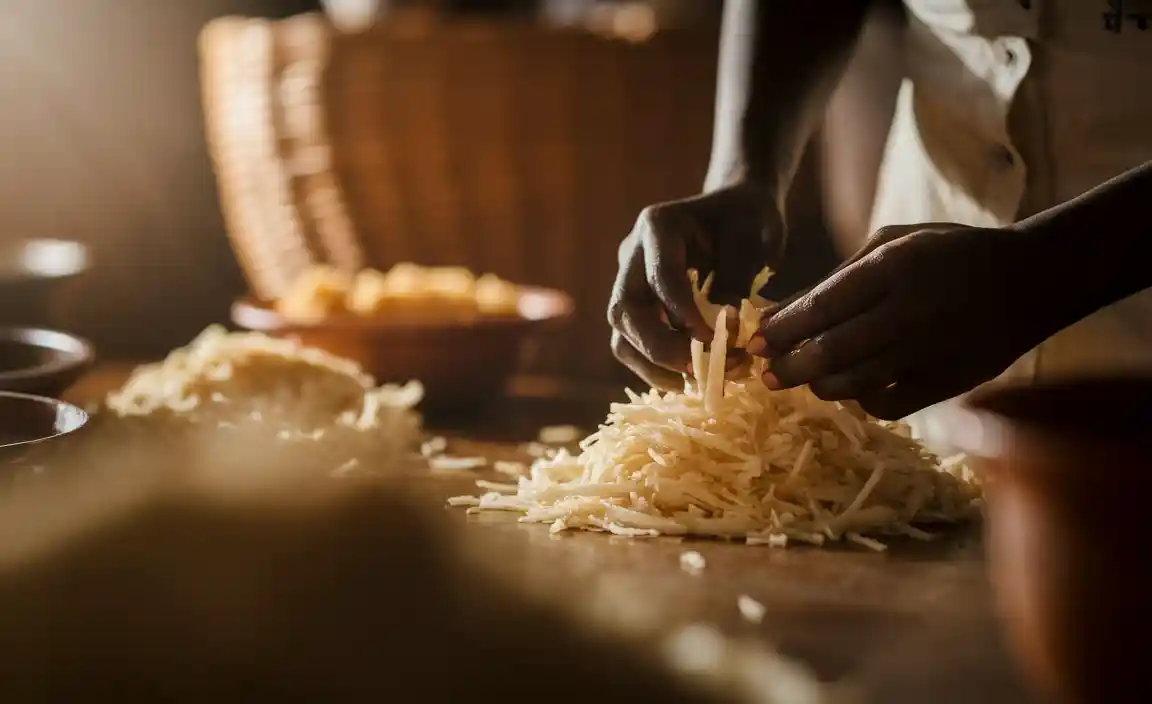Unlock the vibrant taste of Ivorian attieke! This beginner’s guide to Ivorian attieke tasting explores its essential flavors, simple preparation methods, and delicious serving suggestions. Discover how to enjoy this West African cassava classic with confidence.
Hey there, fellow food adventurers! Joseph Bryant here, your guide from FoodsGuider. Ever heard of attieke? It’s a fluffy, slightly sour couscous-like dish made from fermented cassava, and it’s a staple in Côte d’Ivoire. If you’re curious about trying new foods and want an easy, delicious introduction to West African cuisine, you’re in the right place! Sometimes new flavors can seem a little intimidating, but don’t worry. We’re going to break down Ivorian attieke tasting into super simple steps.
We’ll uncover its unique taste, learn how it’s traditionally prepared, and explore fun ways to serve it at home. Get ready to impress yourself (and maybe your friends and family!) with this exciting culinary journey. Let’s dive in and discover the wonderful world of attieke!

What is Ivorian Attieke?
Attieke is a beloved dish originating from Côte d’Ivoire (Ivory Coast), a vibrant country in West Africa. It’s made from fermented and steamed cassava (tapioca/yuca). The fermentation process gives attieke its characteristic slightly sour, tangy flavor and unique grainy texture, similar to couscous but with its own distinct personality.
Cassava is a starchy root vegetable that’s a primary food source for millions of people worldwide. In Côte d’Ivoire, it’s transformed into attieke through a meticulous process that involves grating the cassava, fermenting it, and then steaming it to perfection. This transformation is what makes attieke so special and widely enjoyed.
Its appeal lies in its versatility. Attieke is not just a meal; it’s a culinary experience. It acts as a fantastic base for a variety of sauces, meats, and vegetables, allowing for endless flavor combinations. It’s a testament to how simple ingredients can be elevated into something truly delicious and culturally significant. Understanding its origins and how it’s made is the first step to appreciating its unique taste.
The Essential Flavors of Ivorian Attieke Tasting
When you first taste attieke, you’ll notice a delightful combination of flavors and textures. It’s not just one note; it’s a symphony! Here’s what to expect during your Ivorian attieke tasting adventure:

- Tangy & Slightly Sour: This is the hallmark flavor of attieke, thanks to the fermentation process. It’s a subtle tanginess that wakes up your palate, not overpowering but just enough to be intriguing.
- Subtle Sweetness: Underlying the tang is a gentle sweetness that comes from the cassava itself. It’s mild and natural, balancing the sour notes beautifully.
- Earthy Notes: Cassava has a mild, earthy flavor, which forms the foundation of attieke. This earthiness makes it a grounding component in any dish.
- Fluffy Texture: The texture is key! It’s light, airy, and granular, much like couscous, but often a bit more distinct in its graininess. It’s wonderfully satisfying to eat.
- Absorbent Nature: Attieke is like a flavor sponge! Its true magic happens when it soaks up the delicious sauces and juices from whatever it’s served with. This is where the meal truly comes alive.
The beauty of attieke is how it absorbs the flavors of accompaniments. So, while attieke itself has these core tastes, the overall “flavor” of an attieke dish is a collaborative effort. Think of it as a blank canvas waiting for delicious paints!
How is Attieke Traditionally Prepared?
The traditional preparation of attieke is a fascinating process that highlights the ingenuity of Ivorian cuisine. While you might buy pre-packaged attieke, understanding its roots gives you a deeper appreciation for its taste. The core steps involve:

- Harvesting and Grating: Fresh cassava roots are harvested. The tough outer skin is removed, and the starchy interior is then grated into a fine pulp.
- Fermentation: This is the crucial step that defines attieke. The grated cassava pulp is placed in special raffia bags and allowed to ferment for a period, typically a few days. During fermentation, the starches break down, developing the characteristic sourness. Water is squeezed out, and the pulp becomes more compact.
- Drying and Sieving: After fermentation, the pulp is dried and then sieved to create fine, couscous-like granules.
- Steaming: Finally, these granules are steamed, much like couscous, until they are light, fluffy, and fully cooked. They are often steamed in layers, with water at the bottom of the pot.
Traditionally, this process was done manually, often in rural communities. Today, while many enjoy home-cooked attieke, pre-packaged and processed attieke is readily available in markets and stores, making it accessible for everyday consumption. This traditional method ensures the distinct tangy flavor and unique texture that Ivorian attieke tasting is known for.
Step-by-Step: Preparing Attieke at Home (The Easy Way)

Don’t worry about the full traditional process if you’re just starting! Most people in urban areas and internationally buy pre-made attieke that just needs steaming. This is the perfect beginner-friendly approach. Here’s how to prepare it:
What You’ll Need:
- Pre-packaged attieke granules (available in African or international food stores, or online)
- Water
- A steamer basket or a pot with a steamer insert
- A bowl
- A fork or spoon
The Simple Steaming Process:
- Hydrate the Attieke: Place the dry attieke granules in a bowl. Sprinkle a small amount of water over them. Use your hands to lightly toss and moisten the granules. You want them damp, not soaking wet. Let them sit for about 5 minutes to absorb the water. The granules should look slightly plump.
- Prepare Your Steamer: Fill the bottom of a pot with about an inch or two of water. Bring the water to a boil. Place your steamer basket or insert over the boiling water, ensuring the water doesn’t touch the attieke.
- Steam the Attieke: Transfer the moistened attieke granules into the steamer basket. Spread them out evenly. Cover the pot tightly with a lid.
- Cook Until Fluffy: Steam the attieke for about 10-15 minutes. Resist the urge to stir too much during steaming, as this can make it gummy.
- Fluff and Serve: Once steamed, carefully remove the attieke from the steamer. Use a fork to gently fluff the granules. Make sure there are no clumps. Your attieke is now ready to be served!
Tip: If you find your attieke a bit too sticky after steaming, you can add a tiny bit more cold water and stir gently with a fork to separate the grains. For a richer flavor, some people steam it with a little broth instead of water. Easy peasy!
Classic Ivorian Attieke Serving Combinations
Attieke truly shines when paired with delicious sauces and proteins. The Ivorian attieke tasting experience is often about how the attieke soaks up these flavors. Here are some classic and popular ways to enjoy it:
1. Attieke with Grilled Fish (Poisson Braisé)
This is perhaps the most iconic pairing. Grilled fish, often tilapia or sea bass, marinated in spices like ginger, garlic, chili, and onions, is served alongside a generous portion of steaming attieke. The tender, flaky fish and its spicy marinade are a perfect match for the fluffy attieke.
2. Attieke with Spicy Tomato Sauce (Sauce Tomate Piquante)
A rich, flavorful tomato-based sauce, often simmered with onions, peppers, and sometimes meat or fish, is poured over the attieke. The vibrant sauce coats the grains, infusing every bite with its deliciousness. This is a comforting and deeply satisfying meal.
3. Attieke with Fried Chicken or Beef
Crispy, well-seasoned fried chicken or tender pieces of fried beef are also popular accompaniments. The contrast in textures – crispy protein against fluffy attieke – is delightful. The juices from the meat are a bonus for your attieke!
4. Attieke with “Attiéké-Gout” (Attieke with Everything)
This is a street food favorite! It’s a generous plate of attieke served with various elements like fried fish, shrimp, boiled eggs, fried plantains, fresh tomato and onion salad, and a spicy chili sauce. It’s a complete, flavorful meal in one bowl.
5. Attieke with Vegetables
For a lighter option, attieke can be served with steamed or sautéed vegetables like cabbage, carrots, or green beans, often seasoned with herbs and spices. This makes for a healthy and filling vegetarian or vegan meal.
When you’re doing your own Ivorian attieke tasting, experiment with these! Don’t be afraid to mix and match or even create your own twists. The goal is to create a plate where the attieke acts as the perfect vehicle for all the other amazing flavors.
Understanding the Taste Profile: A Deeper Dive
Let’s break down the sensory experience of Ivorian attieke tasting even further. It’s more than just “sour” or “fluffy.”
The sourness in attieke isn’t aggressive. It’s a gentle lactic fermentation, similar to what you might find in sourdough bread or yogurt, but unique to the cassava. This tanginess cuts through richness, making it a fantastic palate cleanser and allowing you to enjoy larger portions of flavorful accompaniments without feeling heavy.
The sweetness is subtle, almost a whisper, and it’s naturally present in the cassava. It prevents the sourness from becoming too sharp. Imagine biting into a lightly sweet grain that then opens up to a burst of savory sauce – that’s the magic!
The texture, as mentioned, is paramount. It’s light and airy, allowing it to absorb liquids beautifully. When properly prepared, each grain should remain distinct, providing a pleasant chew and a satisfying mouthfeel. This texture also makes it feel less dense and heavy than rice, contributing to its appeal, especially in warmer climates.
The aroma is often mild, with a hint of the fermentation process. It’s not pungent or off-putting; rather, it’s a subtle, inviting scent that complements the overall dish.
For an even clearer understanding of cassava cultivation and processing, you can explore resources from organizations like the Food and Agriculture Organization of the UN (FAO), which provides extensive information on this vital crop worldwide.
Tips for a Successful Ivorian Attieke Tasting
Ready to elevate your attieke experience? Here are some pro tips to make your Ivorian attieke tasting a hit:

- Start with Quality Attieke: If buying pre-packaged, check the expiry date and look for brands that are well-regarded.
- Don’t Overwater: When hydrating, use just enough water to slightly plump the grains. Too much water will make it mushy or gummy.
- Gentle Fluffing: After steaming, use a fork to gently separate the grains. Avoid vigorous stirring, which can break down the texture.
- Serve Hot: Attieke is best enjoyed fresh and hot right after steaming.
- Taste and Adjust: If your attieke seems a little dry after steaming, you can add a tiny splash of water or a drizzle of olive oil while fluffing.
- Pair Wisely: Think about contrasting flavors and textures. Spicy, savory, and saucy accompaniments work best.
- Don’t Be Afraid of Spice: Ivorian cuisine often features a pleasant level of spice. A touch of chili sauce (like a simple harissa or a fresh chili relish) can enhance the attieke.
Attieke vs. Couscous: What’s the Difference?
It’s common to compare attieke to couscous because of their similar appearance and preparation method. However, there are key differences that make each unique.
| Feature | Attieke | Couscous |
|---|---|---|
| Main Ingredient | Fermented cassava pulp | Durum wheat semolina |
| Origin | West Africa (Côte d’Ivoire) | North Africa |
| Flavor Profile | Slightly sour, tangy, subtle sweetness, earthy | Mild, slightly nutty, neutral |
| Texture | Granular, fluffy, distinct grains | Fine or medium grains, fluffy |
| Preparation | Fermented, then steamed | Steamed or rehydrated with hot water/broth |
| Allergen Note | Gluten-free | Contains gluten |
The most significant difference is the base ingredient and the fermentation process for attieke, which imparts its signature tang. Couscous, made from wheat, is more neutral in flavor and gluten-containing. For those with gluten sensitivities or looking for a gluten-free alternative to couscous, attieke is an excellent choice.
Frequently Asked Questions (FAQs) About Ivorian Attieke Tasting
Q1: Is attieke healthy?
Attieke is a good source of carbohydrates, providing energy. As it’s made from cassava, it’s also naturally gluten-free, making it suitable for individuals with celiac disease or gluten sensitivity. Like any food, moderation is key, and its healthiness also depends on what it’s served with.
Q2: Can I eat attieke as a main meal?
Absolutely! Attieke is often served as the base of a complete meal, especially when paired with protein like fish or chicken, and a flavorful sauce. It’s very filling and provides a satisfying base.
Q3: How do I store leftover attieke?
Leftover cooked attieke can be stored in an airtight container in the refrigerator for 2-3 days. Reheat it gently by steaming it again for a few minutes, or briefly in a microwave, adding a tablespoon of water if it seems dry.
Q4: Where can I buy attieke?
Attieke can be found in African specialty food stores, international markets, and online retailers. It usually comes in a dry, granular form, often packaged in plastic bags.
Q5: What does “fermented” cassava taste like?
The fermentation gives attieke a characteristic mild sourness and tanginess, similar to sourdough bread or yogurt, but with its own distinct flavor profile derived from cassava. It adds a pleasant complexity.
Q6: Can I substitute attieke for rice or couscous?
Yes, you can! Given its similar texture to couscous and its role as a starch base in meals, attieke can often be used interchangeably in many recipes. Just remember its unique tangy flavor.
For more on the science of fermentation and its role in food, the National Public Radio (NPR) has excellent articles explaining its benefits.
Conclusion: Embrace the Flavor of Côte d’Ivoire
Embarking on an Ivorian attieke tasting adventure is a delightful way to explore new culinary horizons. From its unique tangy and subtly sweet flavor derived from fermented cassava to its fluffy, absorbent texture, attieke offers a dining experience that is both comforting and exciting. Whether you prepare it at home using the simple steaming method or enjoy it from an African eatery, attieke is a versatile and delicious staple.
We’ve covered its preparation, its essential flavors, and classic pairings that showcase its true potential. Don’t shy away from the unfamiliar; instead, embrace the opportunity to taste something new. With this guide, you’re well-equipped to enjoy attieke and appreciate the rich culinary heritage of Côte d’Ivoire. So, grab some attieke, try a classic pairing like grilled fish with a spicy sauce, and savor the vibrant tastes of West Africa. Happy tasting!